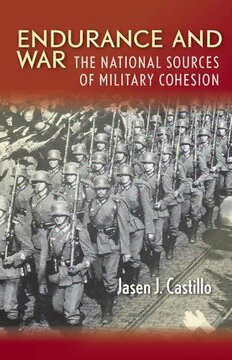
Endurance and War: The National Sources of Military Cohesion PDF
Preview Endurance and War: The National Sources of Military Cohesion
Endurance and War Endurance and War The National Sources of Military Cohesion Jasen J. Castillo Stanford Security Studies An Imprint of Stanford University Press Stanford, California Stanford University Press Stanford, California © 2014 by the Board of Trustees of the Leland Stanford Junior University. All rights reserved. No part of this book may be reproduced or transmitted in any form or by any means, electronic or mechanical, including photocopying and recording, or in any information storage or retrieval system without the prior written permission of Stanford University Press. Printed in the United States of America on acid-free, archival-quality paper Library of Congress Cataloging-in-Publication Data Castillo, Jasen, author Endurance and war: the national sources of military cohesion / Jasen J. Castillo. pages cm. Includes bibliographical references and index. isbn 978-0-8047-8910-3 (cloth : alk. paper) 1. Unit cohesion (Military science)—Case studies. 2. Sociology, Military. 3. Military history, Modern—20th century. I. Title. u22.c39 2014 355.3—dc23 2013035081 Typeset at Stanford University Press in 10/14 Minion Special discounts for bulk quantities of Stanford Security Studies are available to corporations, professional associations, and other organizations. For details and discount information, contact the special sales department of Stanford University Press. Tel: (650) 736-1782, Fax: (650) 736-1784 Contents Acknowledgments ix Preface xi 1 Introduction 1 2 Cohesion Theory: Explaining a Military’s Will to Fight 16 3 Germany, 1944–45 44 4 France, 1940 94 5 The Soviet Union, 1941 141 6 North Vietnam, 1965–73 164 7 The United States, 1968–72 188 8 Conclusion 216 Notes 231 Bibliography 277 Index 299 Figure, Maps, and tables Figure 3.1 Allied and German Rifle Strength, 1918 87 Maps 3.1 Allied Approach to Western Germany, Fall 1944 61 3.2 German Counteroffensive in the West, 1944–45 68 4.1 Western Front, 1940 108 4.2 Meuse Crossing Near Sedan 113 4.3 Meuse Crossing Near Dinant 115 4.4 Assault on Weygand Line 121 5.1 Operation Barbarossa 149 6.1 South Vietnam 171 tables 1.1 The Cases 15 2.1 Indications of Staying Power 20 2.2 Indications of Battlefield Performance 22 2.3 Indications of Regime Control 30 2.4 Indications of Military Autonomy 31 2.5 Hypotheses on Military Cohesion: Four Types of National Armed Forces 34 2.6 Causal Logics 38 2.7 Cases and Predicted Military Cohesion 43 3.1 Assessing Staying Power: Messianic German Armed Forces, 1944–45 76 vii viii Figure, Maps, and tables 3.2 Assessing Battlefield Performance: Messianic German Armed Forces, 1944–45 77 3.3 German and Allied Battle Casualties, September 1944–May 1945 78 3.4 U.S. Monthly Battle Deaths, June 1944–April 1945 79 3.5 Assessing Staying Power: Professional German Armed Forces, 1917–18 90 3.6 Assessing Battlefield Performance: Professional German Armed Forces, 1917–18 91 3.7 German Casualties, World War I 92 3.8 German Casualties, World War II 92 4.1 Total Casualties from Battle of France, May 10–June 22, 1940 125 4.2 Assessing Staying Power: Apathetic French Armed Forces, 1940 138 4.3 Assessing Battlefield Performance: Apathetic French Armed Forces, 1940 138 4.4 Assessing Staying Power: Professional French Armed Forces, 1914–18 138 4.5 Assessing Battlefield Performance: Professional French Armed Forces, 1914–18 139 4.6 French Casualties: World War II 139 4.7 French Casualties: World War I 139 5.1 Soviet and German Casualties, June 22, 1941, to January 1942 160 5.2 Assessing Staying Power: Authoritarian Soviet Armed Forces, 1941 161 5.3 Assessing Battlefield Performance: Authoritarian Soviet Armed Forces, 1941 161 5.4 Russian Casualties: World War I 162 5.5 Soviet Union Casualties: World War II 162 6.1 American and North Vietnamese Casualties, 1965–73 186 6.2 Assessing Staying Power: Messianic North Vietnamese Army, 1965–73 186 6.3 Assessing Battlefield Performance: Messianic North Vietnamese Army, 1965–73 186 7.1 American Force Levels and Killed in Action, 1965–71 206 7.2 Communist and American Losses, 1968 206 7.3 Discipline Problems in American Forces 212 7.4 Assessing Staying Power: Professional U.S. Military, 1968–72 213 7.5 Assessing Battlefield Performance: Professional U.S. Military, 1968–72 213 acknowledgments Not only does a book project take a long time—longer than anyone antici- pates!—it also requires a great deal of help from family, friends, and colleagues. Both John Mearsheimer and Charles Glaser at the University of Chicago guided me as I started this project. While John forcefully demanded that my book offer a simple answer to a complex question, Charlie reminded me that the world is complicated. They remain important mentors and sources of inspiration. Both encourage their students to use the theories and methods of social science to address important questions in national security policy. Along the way, a number of scholars commented on portions or all of the manuscript. For their insights, I thank Alexander Wendt, Robert Pape, Stephen Walt, Duncan Snidal, Keir Lieber, Negeen Pegahi, Adam Grissom, Jeffrey Mar- tini, Dan Reiter, Taylor Fravel, Owen Cote, Charles Hermann, Joseph Cerami, Domonic Bearfield, Arnold Vedlitz, Adam Seipp, Larry Napper, Brian Linn, and Valerie Hudson. I also appreciate contributions from participants who attend- ed presentations I made at the Massachusetts Institute of Technology, the U.S. Naval War College, Duke University, and the RAND Corporation. Christopher Layne, Michael Desch, Paul Kapur, and David Edelstein deserve special thanks for reading the entire manuscript and providing sharp but useful criticism. I am particularly indebted to Alexander Downes, who read the manuscript sev- eral times, helped me improve the argument significantly, and was always avail- able for discussions. Alex embodies the model colleague: a tough reader but also eager to help me make my argument. I pity the scholar that does not have a friend like him as an ally. I received generous research support from the Scowcroft Institute of Inter- ix
